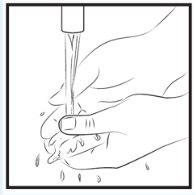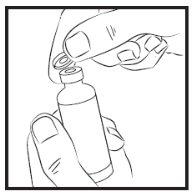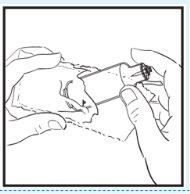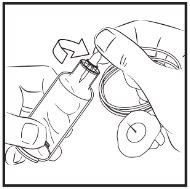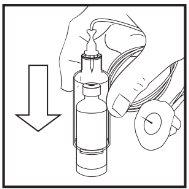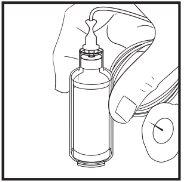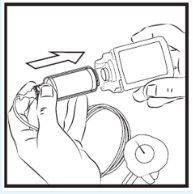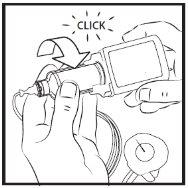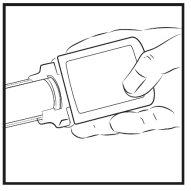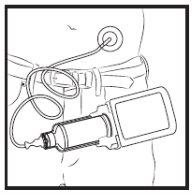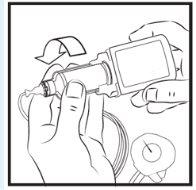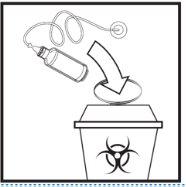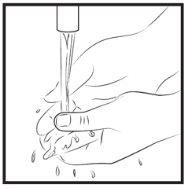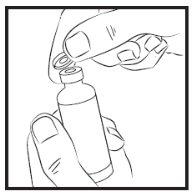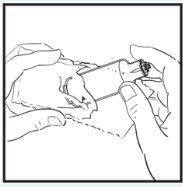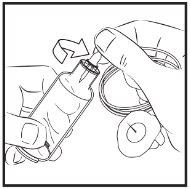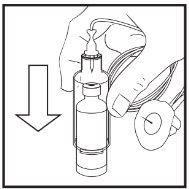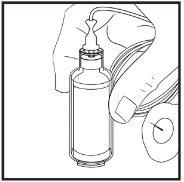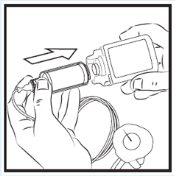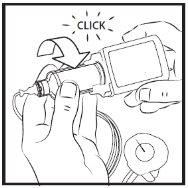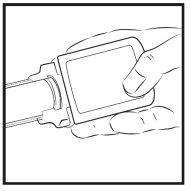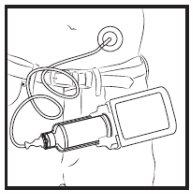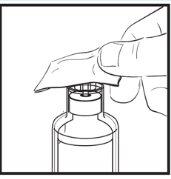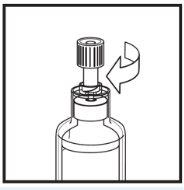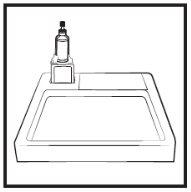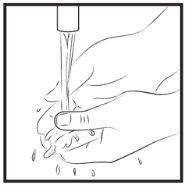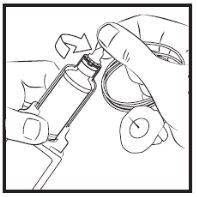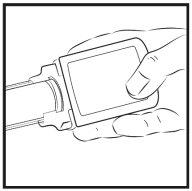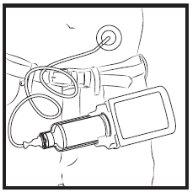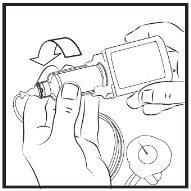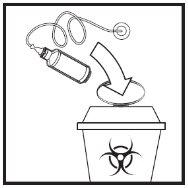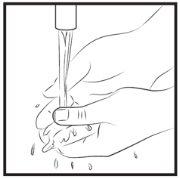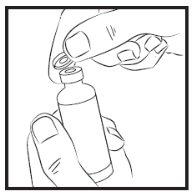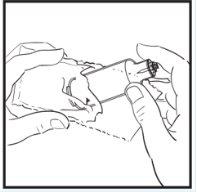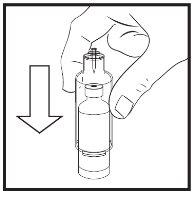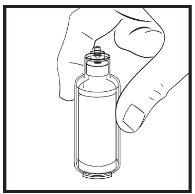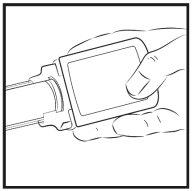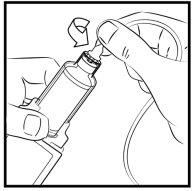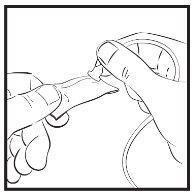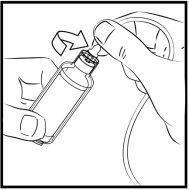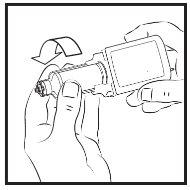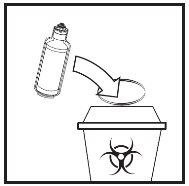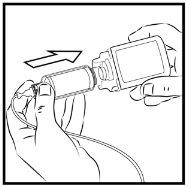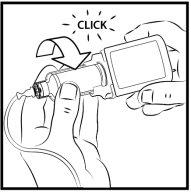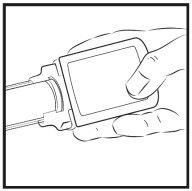
APO-GO POD 5 mg/ml SOLUTION FOR INFUSION IN CARTRIDGE
Ask a doctor about a prescription for APO-GO POD 5 mg/ml SOLUTION FOR INFUSION IN CARTRIDGE

How to use APO-GO POD 5 mg/ml SOLUTION FOR INFUSION IN CARTRIDGE
Introduction
Package Leaflet: Information for the User
APO-go POD 5mg/ml solution for infusion in a cartridge
Apomorphine hydrochloride hemihydrate
Read all of this leaflet carefully before you start using this medicine because it contains important information for you.
- Keep this leaflet, you may need to read it again.
- If you have any further questions, ask your doctor, pharmacist, or nurse.
- This medicine has been prescribed for you only. Do not pass it on to others. It may harm them, even if their signs of illness are the same as yours.
- If you experience any side effects, talk to your doctor, pharmacist, or nurse. This includes any possible side effects not listed in this leaflet. See section 4.
Contents of the pack
- What APO-go POD is and what it is used for
- What you need to know before you start using APO-go POD
- How to use APO-go POD
- Possible side effects
- Storing APO-go POD
- Contents of the pack and other information
1. What APO-go POD is and what it is used for
APO-go POD contains apomorphine hydrochloride hemihydrate (referred to in this leaflet as apomorphine).
Each milliliter of solution contains 5 mg of apomorphine.
Apomorphine belongs to a group of medicines called dopaminergic agonists, which are used to treat Parkinson's disease. Apomorphine helps reduce the amount of time spent in the "off" state (or immobile) in patients who have been previously treated for Parkinson's disease with levodopa and/or other dopaminergic agonists. Your doctor, pharmacist, or nurse will help you recognize the signs that indicate when you should use this medicine. This medicine is for use in adults only.
Despite the name of the medicine, apomorphine does not contain morphine.
2. What you need to know before you start using APO-go POD
Before using APO-go POD, your doctor will perform an ECG (electrocardiogram) and ask you to indicate all other medicines you are taking. This ECG will be repeated in the first few days of treatment and at any time your doctor considers it necessary. Your doctor will also ask you about other diseases you may have, especially those related to the heart. Some of the questions and complementary tests may be repeated at each medical visit. If you experience any symptoms that may be related to the heart, such as palpitations, fainting, or dizziness, you should inform your doctor immediately. Additionally, if you experience diarrhea or start taking a new medicine, you should also inform your doctor.
Do not use APO-go POD if:
- you are under 18 years old.
- you have breathing difficulties
- you have dementia or Alzheimer's disease.
- you suffer from a mental illness with symptoms such as hallucinations, delusions, thought disorders, loss of contact with reality.
- you have liver problems.
- you have severe dyskinesia (involuntary movements) or severe dystonia (sustained or repetitive movements that can cause a fixed posture) during the "on" periods due to treatment with levodopa.
- you are allergic to apomorphine or any of the other components of this medicine (listed in section 6).
- you are taking medicines for nausea and vomiting of a certain class (5HT3 antagonists), such as ondansetron, granisetron, dolasetron, and palonosetron.
- you are taking medicines for diarrhea, e.g., alosetron.
Warnings and precautions
Consult your doctor, pharmacist, or nurse before starting to use APO-go POD if:
- you have kidney problems.
- you have lung problems.
- you have heart problems.
- you have low blood pressure or feel faint or dizzy when standing up.
- you are taking medication for high blood pressure.
- you have nausea or vomiting.
- you have a mental disorder when starting to use APO-go POD.
- you are elderly or weak.
- you or a family member have abnormalities in the electrocardiogram (ECG) known as QT interval prolongation syndrome.
Inform your doctor if you or your family members or caregivers notice that you are developing impulses or desires to behave in an unusual way and cannot resist the impulse, need, or temptation to carry out certain activities that may be harmful to you or others. These behaviors are called impulse control disorders and may include addictive gambling, overeating, excessive spending, abnormally increased sexual desire, or an increase in sexual thoughts or feelings. Your doctor may need to adjust or interrupt your dose.
Some patients develop symptoms related to addiction that lead to a compulsive desire to consume high doses of APO-go POD and other medicines used in the treatment of Parkinson's disease.
If you experience any of the situations described, please inform your doctor, pharmacist, or nurse.
Children and adolescents
APO-go POD should not be used in children and adolescents under 18 years old.
Using APO-go POD with other medicines
Inform your doctor, pharmacist, or nurse if you are taking, have recently taken, or might take any other medicines.
Consult your doctor, pharmacist, or nurse before starting to use your medicine if:
- you are using medicines that affect heart rate. This includes medicines used to treat heart rhythm problems (such as quinidine and amiodarone), for depression (including tricyclic antidepressants, such as amitriptyline and imipramine), and for bacterial infections (macrolide antibiotics such as erythromycin, azithromycin, and clarithromycin) and domperidone.
- you are taking ondansetron (a medicine used to treat nausea and vomiting) as this may cause severe low blood pressure and loss of consciousness.
If you use this medicine at the same time as others, the effect of your medicines may be altered. This occurs particularly with:
- medicines such as clozapine for treating mental disorders.
- medicines for reducing high blood pressure.
- other medicines for treating Parkinson's disease.
- medicines for preventing nausea and vomiting, such as ondansetron, granisetron, dolasetron, palonosetron, and medicines for treating diarrhea, such as alosetron (if you are taking these medicines, you should not use APO-go POD; see section 2).
- antidopaminergic medicines such as haloperidol, chlorpromazine, promethazine, prochlorperazine, metoclopramide, levopromazine, and droperidol.
Your doctor will inform you if you need to change the dose of APO-go POD or any other medicine you are taking.
If you are taking levodopa (another medicine for Parkinson's disease), in addition to apomorphine, your doctor should perform regular blood tests.
Using APO-go POD with food and drinks
Food and drinks do not affect the way this medicine works.
Pregnancy and breastfeeding
APO-go POD should not be used during pregnancy, unless it is strictly necessary.
It is not known if apomorphine is excreted in breast milk. Inform your doctor if you are breastfeeding or plan to breastfeed. Your doctor will explain if you should continue or stop breastfeeding, or continue or stop taking the medicine.
If you are pregnant or breastfeeding, think you may be pregnant, or plan to become pregnant, consult your doctor or pharmacist before using this medicine.
Driving and using machines
APO-go POD may cause drowsiness and a strong desire to sleep. You should not drive or operate machinery if this medicine causes this effect.
APO-go POD contains sodium metabisulfite.
This medicine may cause severe allergic reactions and bronchospasm (sudden feeling of suffocation) because it contains sodium metabisulfite.
This medicine contains less than 23 mg of sodium (1 mmol) per 20 ml cartridge; it is essentially "sodium-free".
3. How to use APO-go POD
Before using APO-go POD, your doctor will check that you tolerate this medicine and an antiemetic medicine (domperidone) that you must take at the same time.
Follow exactly the administration instructions of this medicine indicated by your doctor, pharmacist, or nurse. In case of doubt, consult your doctor, pharmacist, or nurse again.
Do not use APO-go POD if:
- The solution turns green.
- The solution is cloudy or contains particles in suspension.
Where to inject APO-go POD
- Inject APO-go POD under the skin (subcutaneously) as indicated by your doctor, pharmacist, or nurse.
- Do not inject APO-go POD into a vein.
APO-go POD is designed to be administered in continuous infusion with an infusion pump (also called a perfuser) and a cartridge adapter CronoBell Sleeve. The perfuser you will receive will be the Crono APO-go III or Crono PAR4 20 model.
How much to use
The amount of APO-go POD you should use and the total time you should receive your medicine daily will depend on your personal needs. Your doctor will discuss this with you and indicate the amount of medicine that should be administered. This amount that works best for you will be determined during your specialist visit. The average hourly infusion dose is between 2 mg and 8 mg of apomorphine. Continuous infusion is usually administered while you are awake and generally interrupted before sleeping at night. The daily amount of apomorphine you receive should not exceed 100 mg. Your doctor, pharmacist, or nurse will decide which dose is most suitable for you.
You can use a cartridge for a maximum of 48 hours, provided that a new infusion line is used every 24 hours and in a different area of the body.
It is not necessary to dilute APO-go POD before use. Additionally, it should not be mixed with other medicines.
Your doctor or nurse will teach you how to prepare and use APO-go POD. Also, consult the instructions on how to prepare the infusion with APO-go POD at the end of this leaflet "Preparation of the infusion with Apo-go POD".
If you use more APO-go POD than you should
In case of overdose or accidental ingestion, consult your doctor or pharmacist immediately or call the Toxicology Information Service, phone 915.620.420, indicating the medicine and the amount ingested.
- Inform your doctor or contact the emergency service of the nearest hospital immediately.
- It is important to administer the correct dose of APO-go POD and not use more than the amount recommended by your doctor. Higher doses may cause a slower heart rate, excessive vomiting, excessive drowsiness, and/or difficulty breathing. You may also feel dizzy or faint, especially when standing up, due to low blood pressure. Lying down with your feet elevated will help treat low blood pressure.
If you forget to use APO-go POD
- Wait for the next dose. Do not use a double dose to make up for forgotten doses.
If you stop treatment with APO-go POD
- Consult your doctor before stopping the use of APO-go POD to decide if it is or is not appropriate.
If you have any further questions about the use of this medicine, ask your doctor, pharmacist, or nurse.
4. Possible side effects
Like all medicines, this medicine can cause side effects, although not everybody gets them.
If you experience an allergic reaction, stoptreatment with APO-go POD and contact your doctor or go to the emergency service of the nearest hospital immediately. The symptoms of an allergic reaction may include:
- Rash.
- Difficulty breathing.
- Swelling of the face, lips, throat, or tongue.
Inform your doctor if you think the medicine is making you feel unwell or if you experience any of the following side effects:
Very common: may affect more than 1 in 10 people
- Appearance of lumps under the skin at the injection site that are painful, annoying, and may become red and itchy. To avoid the appearance of these lumps, it is recommended to change the injection site each time the needle is inserted.
- Hallucinations (seeing, hearing, or perceiving things that do not exist).
Common: may affect up to 1 in 10 people
- Nausea or vomiting, especially when starting treatment with APO-go POD. Treatment with domperidone should be started at least two days before treatment with APO-go POD to avoid nausea and vomiting. If you are taking domperidone and still feel nausea or vomiting, or if you are not taking domperidone and have nausea or vomiting, inform your doctor, pharmacist, or nurse as soon as possible.
- Excessive drowsiness.
- Confusion or hallucinations.
- Feeling dizzy or lightheaded.
- Feeling drowsy for a short period, especially when starting treatment. This usually resolves within a few weeks.
Uncommon: may affect up to 1 in 100 people
- Increased involuntary movements or increased tremors during the "on" periods
- Hemolytic anemia (abnormal destruction of red blood cells in blood vessels or other parts of the body). This is an uncommon side effect that may occur in patients who also take levodopa.
- Sudden sleep.
- Rash.
- Difficulty breathing.
- Ulceration at the injection site and tissue damage.
- Reduced platelet count, which increases the risk of bleeding or bruising.
- Feeling dizzy or lightheaded when standing up from a sitting or lying position due to low blood pressure.
Rare: may affect up to 1 in 1,000 people
- Eosinophilia, an abnormally high number of white blood cells in the blood or tissues.
Frequency not known: frequency cannot be estimated from the available data
- Swelling of arms, legs, feet, or hands.
- Inability to resist the impulse, need, or temptation to perform actions that may be harmful to you or others, such as:
- Strong desire to gamble or bet excessively, despite serious personal or family consequences.
- Alteration or increase in sexual interest and behavior, affecting the patient or others, for example, an increase in sexual desire.
- Excessive buying or spending in an uncontrolled manner.
- Binge eating (eating large amounts of food in short periods) or compulsive eating (eating more food than normal and more than necessary to satisfy appetite).
- Fainting.
- Aggression, agitation.
- Headache.
Tell your doctor if you experience any of these behaviors; your doctor will agree with you on how to control or reduce the symptoms.
Reporting of side effects
If you experience any side effects, talk to your doctor, pharmacist, or nurse. This includes any possible side effects not listed in this leaflet. You can also report side effects directly through the Spanish Pharmacovigilance System for Human Use Medicines: www.notificaRAM.es. By reporting side effects, you can help provide more information on the safety of this medicine.
5. Storing APO-go POD
Keep this medicine out of the sight and reach of children.
Do not use this medicine after the expiry date stated on the label and carton after EXP. The expiry date is the last day of the month indicated.
Do not store above 30°C.
Once opened, APO-go POD should be used immediately. Any unused solution should be discarded after 48 hours, and a new cartridge should be used.
Do not use this medicine if you notice that the solution has turned green. It should only be used if the solution is clear, colorless, and free of visible particles.
Be careful not to splash the solution or spill it on the floor, as it may stain green.
After use, the infusion line, cartridge adapter (CronoBell Sleeve), and cartridge should be discarded and placed in a container for sharp objects.
Medicines should not be disposed of via wastewater or household waste. In case of doubt, ask your pharmacist how to dispose of the packaging and medicines that are no longer needed. This will help protect the environment.
6. Container Contents and Additional Information
Composition of APO-go POD
- The active ingredient is apomorphine hydrochloride hemihydrate. One milliliter of APO-go POD solution contains 5 mg of apomorphine hydrochloride hemihydrate. Each 20 ml cartridge contains 100 mg of apomorphine hydrochloride hemihydrate.
- The other components are:
- sodium metabisulfite (E-223)
- hydrochloric acid, concentrated (for pH adjustment)
- water for injectable preparations
Please refer to section 2: APO-go POD contains sodium metabisulfite.
Appearance of APO-go POD and Container Contents
APO-go POD is a solution for infusion in a cartridge. The solution is transparent and colorless.
Container Contents
APO-go POD is supplied in a transparent siliconized glass cartridge, with a chlorobutyl rubber stopper (with an aluminum seal and a purple flip-off cap) and a siliconized chlorobutyl rubber plunger
Each pack contains 5 cartridges with 20 ml of solution arranged in a cardboard tray inside an outer cardboard box.
The CronoBell Sleeve cartridge adapter is supplied separately in blister packs containing 5 units.
Luer lock single-use caps will be supplied as needed.
Where pack sizes are available:
Packs of 25 cartridges contain 5 packs of 5 cartridges.
Packs of 50 cartridges contain 10 packs of 5 cartridges.
Only certain pack sizes may be marketed.
Marketing Authorization Holder and Manufacturer
STADA Arzneimittel AG
Stadastraße 2-18
61118 Bad Vilbel
Germany
You can request more information about this medication by contacting the local representative of the marketing authorization holder:
ITALFARMACO S.A.
San Rafael, 3
28108 Alcobendas (Madrid)
This medication is authorized in the Member States of the European Economic Area and in the United Kingdom (Northern Ireland) under the following names:
Germany: APO-go 5 mg/ml Infusionslösung in einer Patrone
Austria: APO-go 5 mg/ml Infusionslösung in einer Patrone
Denmark: APO-go Pod
Slovenia: APO-go 5 mg/ml raztopina za infundiranje v vložku
Spain: APO-go POD 5 mg/ml solución para perfusión en cartucho
Greece: APO-go POD 5 mg/ml Δι?λυμα για ?γχυση σε φυσ?γγιο
Ireland: APO-go POD 5 mg/ml solution for infusion in cartridge
Luxembourg: APO-go POD 5 mg/ml solution pour perfusion en cartouche
Norway: Britaject
Netherlands: APO-go Pod 5 mg/ml oplossing voor infusie in een patroon
Portugal: Apo-go POD 5 mg/ml solução para perfusão em cartucho
United Kingdom (Northern Ireland): APO-go POD 5 mg/ml solution for infusion in cartridge
Romania: APO-go 5 mg/ml solutie perfuzabila în cartu?
Sweden: APO-go för POD 5 mg/ml infusionsvätska, lösning i cylinderampull
Date of the last revision of this leaflet: September 2024
Detailed information on this medication is available on the website of the Spanish Agency for Medicines and Health Products (AEMPS) (http://www.aemps.gob.es/
Preparation of the Infusion with APO-go POD
Wash and dry your hands before handling any infusion equipment.
Before starting, make sure you have a container for sharp objects and the following elements:
- 1 infusion set* (for each 24 hours)
- 1 Cronobell Sleeve cartridge adapter*
- 1 cartridge (containing the medication)
- 1 infusion pump (Crono APO-go III infusion pump or Crono PAR4 20 infusion pump) with fitting piece*.
- 1 tray*
You may also be provided with:
- 1 box of sterile single-use Luer locks*
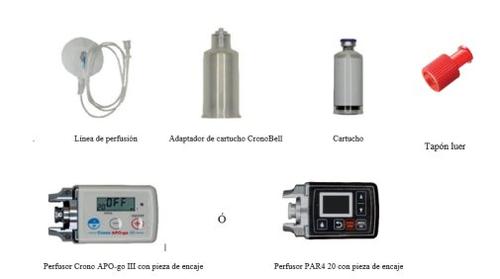
(*) The packaging does not contain the infusion set, the CronoBell Sleeve cartridge adapter, the infusion pump with fitting piece to activate the infusion, the tray, and the Luer locks. These elements are supplied separately.
Please note that there are three different scenarios for using and changing the cartridge, which are shown below. Please follow the instructions according to the indications of your healthcare professional.
Instructions for Using the Cartridge for One Day
Please follow the following steps if you use the cartridge for one day, without changing the cartridge during the day:
|
|
|
|
|
|
|
|
|
|
|
|
|
|
|
|
|
|
|
|
|
At the end of the infusion, stop the pump and disconnect the infusion line from the body. Infusion is usually stopped before sleeping. |
| |
|
|
|
|
|
|
|
|
|
|
|
|
|
|
|
|
|
|
| How to Store the Pump with the Cartridge and CronoBell Sleeve for the Night (Steps 11-13) |
|
At the end of the infusion, stop the pump. Infusion is usually stopped before sleeping. |
Place the pump upright on the tray with the cartridge/adapter still in place. Separate the infusion line from the pump and discard it in the sharps container. Clean any spill with an alcohol wipe. | |
|
| How to Start the Infusion the Next Morning (Steps 14-17) |
|
| |
|
|
|
|
|
|
|
|
|
At the end of the infusion, stop the pump and separate the infusion line from the body. |
|
|
Instructions for Changing the Cartridge During the Day
If you use the cartridge for more than one day, it may be necessary to use a new cartridge when the old one runs out. Please follow the steps below to change the cartridge during the day:
|
|
|
|
|
|
|
|
|
|
|
|
|
|
|
|
To avoid contamination, do not touch the end of the infusion line except to clean it. |
|
|
|
|
|
|
|
| ||
|
| |
|
|
Note: Each perfusion line requires a different insertion technique. The choice of needle will be determined by the doctor.
The user guides for the pump and the CronoBell Sleeve cartridge adapter are intended for healthcare professionals. If you want to consult detailed information on how to prepare APO-go POD for continuous perfusion and additional administrations (known as a booster or bolus dose), consult with healthcare professionals.
The administration infuser of this product is different from that of other apomorphine medications available on the market. Therefore, if you have changed from one medication to another, you must relearn how to use it under the supervision of a healthcare professional.
Detailed and updated information on this medication is available on the website of the Spanish Agency for Medicines and Health Products (AEMPS) http://www.aemps.gob.es/
- Country of registration
- Active substance
- Prescription requiredYes
- Manufacturer
- This information is for reference only and does not constitute medical advice. Always consult a licensed doctor before taking any medication. Oladoctor is not responsible for medical decisions based on this content.
- Alternatives to APO-GO POD 5 mg/ml SOLUTION FOR INFUSION IN CARTRIDGEDosage form: INJECTABLE, 10 mg/mLActive substance: apomorphineManufacturer: Stada Arzneimittel AgPrescription requiredDosage form: INJECTABLE, 10 mg/ml apomorphine hydrochlorideActive substance: apomorphineManufacturer: Stada Arzneimittel AgPrescription requiredDosage form: INJECTABLE PERFUSION, 5 mg/mLActive substance: apomorphineManufacturer: Stada Arzneimittel AgPrescription required
Alternatives to APO-GO POD 5 mg/ml SOLUTION FOR INFUSION IN CARTRIDGE in other countries
The best alternatives with the same active ingredient and therapeutic effect.
Alternative to APO-GO POD 5 mg/ml SOLUTION FOR INFUSION IN CARTRIDGE in Poland
Alternative to APO-GO POD 5 mg/ml SOLUTION FOR INFUSION IN CARTRIDGE in Ukraine
Online doctors for APO-GO POD 5 mg/ml SOLUTION FOR INFUSION IN CARTRIDGE
Discuss dosage, side effects, interactions, contraindications, and prescription renewal for APO-GO POD 5 mg/ml SOLUTION FOR INFUSION IN CARTRIDGE – subject to medical assessment and local rules.




